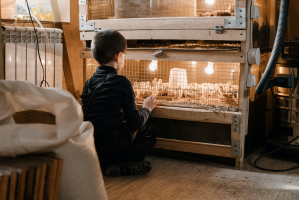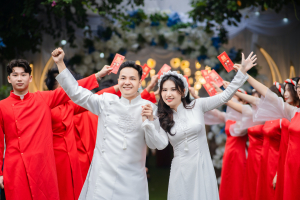Top 12 Best Classification Essay Examples
Classification essays categorize data into components and provide comments on each category. Understanding this essay type is crucial for a successful writing ... read more...process. Let's explore the Toplist collection of classification essay examples to improve your understanding.
-
Essay topic: Categorize common breakfast items
Answer:Breakfast is considered the most important meal of the day. It provides us with the energy and nutrition needed to kick-start our day. From traditional dishes to modern favorites, breakfast items are diverse and reflect the rich culinary heritage and cultural diversity of the world. However, for most households, the most common breakfast items are cereals, eggs, pancakes and fruits.
Cereals are a popular breakfast choice. They offer convenience and come in various flavors and textures. They can be hot or cold. Hot cereals, like oatmeal and cream of wheat, provide warmth and comfort, while cold cereals, like cornflakes, granola, and muesli, offer quick, ready-to-eat options. Cereal grains like oats, wheat, rice, and corn form the base of these breakfast items, often paired with milk or yogurt to create a satisfying and nutritious meal.
Eggs are another versatile breakfast staple. They can be prepared in numerous ways, each offering a distinct culinary experience. This category includes classics such as scrambled eggs, fried eggs, boiled eggs, omelets, and egg Benedict. The versatility of eggs allows for a wide range of flavor profiles, from simple and savory to rich and indulgent, catering to various taste preferences.
Pancakes have a fluffy texture and delightful taste, and they are a beloved breakfast item enjoyed around the world. This category includes traditional pancakes, buttermilk pancakes, blueberry pancakes, and whole-grain pancakes. Toppings such as maple syrup, fresh fruits, whipped cream, and chocolate chips complement the flavor of pancakes, adding a touch of indulgence to the morning meal.
Fresh fruits play a vital role in breakfast. They offer natural sweetness, vibrant colors, and essential vitamins and minerals. This category encompasses a wide variety of fruits, including bananas, berries, oranges, apples, and melons. Fruits can be enjoyed whole, as fruit salads, or as accompaniments to other breakfast items. They provide a refreshing and nutritious addition to the breakfast table, contributing to a balanced and wholesome meal.
As can be seen, having a delicious breakfast with nutritional benefits is not difficult. Whether enjoy cereals, eggs, pancakes, or fresh fruits, these breakfast items should provide people with delicious and nourishing notes to start the day.
Cite this page (APA 7th edition): Toplist Joint Stock Company. (n.d.). Types of breakfast foods. toplist.info. https://toplist.info/top/types-of-breakfast-foods-152472.htm

Image via Unsplash 
Image via Unsplash -
Essay topic: Explore ways to overcome anxiety
Answer:
Anxiety is a common experience for many people, and learning how to manage and overcome it is vital for overall well-being. Overcoming anxiety can be categorized into three ways: Cognitive-behavioral therapy, mindfulness and meditation, and physical exercise.
The first method of relieving anxiety is Cognitive-Behavioral Therapy (CBT). CBT equips individuals with the tools to identify and challenge their negative thought patterns and behaviors. By restructuring irrational beliefs and engaging in gradual exposure to anxiety-provoking situations, individuals can learn to cope with and eventually overcome their anxiety. Numerous studies have demonstrated the effectiveness of CBT in reducing anxiety symptoms and preventing relapse.
Mindfulness practices, including meditation and deep breathing exercises, are useful in managing anxiety. Research suggests that regular mindfulness practice can alter brain activity, reducing the reactivity of the amygdala - the brain region responsible for processing fear. By cultivating a non-judgmental awareness of the present moment, individuals can interrupt the cycle of anxious thoughts and bring about a sense of calm and balance. Studies have indicated that mindfulness-based interventions can significantly decrease anxiety and improve overall psychological well-being.
Engaging in regular physical exercise is another effective strategy for reducing anxiety. Exercise promotes the release of endorphins - the body's natural stress-relieving hormones while also providing a distraction from worrisome thoughts. Additionally, physical activity can help individuals regulate their sleep patterns, improve self-esteem, and reduce the physical symptoms of anxiety. Research has shown that both aerobic and anaerobic exercises can lead to a reduction in anxiety levels, making regular exercise a valuable tool for managing anxiety.
In conclusion, the management and overcoming of anxiety can be achieved through a variety of evidence-based techniques. Cognitive-behavioral therapy, mindfulness and meditation, and physical exercise support all offer valuable strategies for individuals to address and alleviate their anxiety symptoms.Cite this page (APA 7th edition): Toplist Joint Stock Company. (n.d.). Ways to overcome anxiety. toplist.info. https://toplist.info/top/ways-to-overcome-anxiety-152492.htm

Image via Unsplash 
Image via Unsplash -
Essay topic: Explore various types of leadership styles in the workplace
Answer:
Leadership styles play a pivotal role in the workplace, shaping the organizational culture, motivating employees, and ultimately impacting business success. Different leaders employ varying approaches to directing, managing, and motivating their teams. Leaders are categorized into six types: effective leadership, autocratic leadership, transformational leadership, democratic leadership, laissez-faire leadership, and servant leadership.
Effective leadership is a cornerstone of organizational success, and it comes in various forms, each with its distinct characteristics and impact. For most workplaces, leaders can be divided into several groups including autocratic leadership, transformational leadership, democratic leadership, laissez-faire leadership, and servant leadership.
Autocratic leadership is characterized by a top-down approach, where the leader holds significant authority and makes decisions with minimal input from the team. This style emphasizes strict control and clear hierarchical structures. While it can lead to swift decision-making and clear guidelines, it may stifle creativity and result in a lack of employee engagement.
Transformational leaders inspire and motivate their teams by setting a compelling vision and empowering their members to achieve it. They often foster a culture of innovation, encourage personal growth, and promote a sense of collective purpose. This style tends to generate high levels of loyalty, creativity, and commitment among team members.
In contrast to the autocratic style, democratic leadership involves shared decision-making and collaboration among team members. Leaders who adopt this style value the input of their employees, fostering a sense of shared responsibility and ownership. While it can lead to slower decision-making, democratic leadership often promotes a positive work culture and high employee morale.
Laissez-faire leaders adopt a hands-off approach, providing significant autonomy to their team members. They entrust their employees to make decisions and manage their tasks independently. While this style can promote creativity, it may also result in a lack of guidance and direction, leading to potential disorganization or lack of accountability.
Servant leadership focuses on the well-being and development of the team, with the leader prioritizing the needs of their employees. They emphasize empathy, active listening, and support, aiming to enable their team members to reach their full potential. This approach often fosters a strong sense of trust and collaboration within the organization.
In the tapestry of leadership, various styles intertwine and form a complex mosaic that shapes organizational dynamics. Each style, from autocratic and transformational to democratic, laissez-faire, and servant leadership, leaves its unique imprint on the workplace environment.Cite this page (APA 7th edition): Toplist Joint Stock Company. (n.d.-b). Types of leadership styles in the workplace. toplist.info. https://toplist.info/top/types-of-leadership-styles-in-the-workplace-152495.htm

Image via Unsplash 
Image via Unsplash -
Essay topic: Divide social media oversharers into different categories
Answer:
In the vast landscape of social media, we encounter a variety of personas that engage in oversharing, often categorizing them into distinct types. Social media oversharers can be divided into several types, including the food photographer, the constant updater, the vague poster, and the drama instigator.
The food photographer is an ever-present figure in the realm of social media. With a keen eye for presentation and a penchant for gastronomic delights, they capture every meal in exquisite detail. Whether it's a gourmet dish at a fancy restaurant or a homemade culinary creation, the food photographer must document and share their dining experiences with the online world. Their posts often exude a sense of visual indulgence, provoking both admiration and culinary envy among their peers.
The constant updater is characterized by their relentless stream of posts, providing constant insights into their daily activities, thoughts, and emotions. From mundane moments to significant life events, they offer an unfiltered, real-time portrayal of their lives. No detail is too trivial to share, and their presence in the digital realm is marked by a continuous flow of updates that offer an unfiltered window into their world.
In stark contrast to the constant updater, the vague poster operates in a realm of ambiguity and mystery. They share enigmatic posts that offer little context or substance, often leaving their audience puzzled and intrigued. Whether through cryptic messages, ambiguous quotes, or perplexing images, the vague poster cultivates an aura of mystique, inviting others to speculate and decode the underlying meaning behind their posts.
The drama instigator is a catalyst for digital conflict and controversy. Their posts are frequently marked by provocative statements, incendiary opinions, and a penchant for stirring up emotional reactions. Whether intentionally or inadvertently, they spark heated discussions and debates, often polarizing their social media circles and generating a digital spectacle around their virtual persona.In social media, the dynamics of oversharing manifest in various forms, each encapsulating distinct traits and communication styles. Whether being a food photographer, the constant updater, the vague poster, or the drama instigator, collectively all contribute to the multifaceted nature of digital communication, shaping the way we engage, interact, and perceive the world through the lens of social media.
Cite this page (APA 7th edition): Toplist Joint Stock Company. (n.d.-c). Categories of social media oversharers. toplist.info. https://toplist.info/top/categories-of-social-media-oversharers-152496.htm

Image via Unsplash 
Image via Unsplash -
Essay topic: Classify the types of people you encounter in a coffee shop
Answer:
Coffee shops have evolved into bustling hubs that attract a diverse array of individuals. Observing the various personas that frequent these establishments can provide insight into the different types of coffee enthusiasts. People in a coffee shop are categorized into several groups including coffee connoisseur, the laptop camper, the caffeine addict, and the social butterfly.
The coffee connoisseur embodies a refined appreciation for the art of coffee, often seen savoring each sip with a discerning palate. They are known for their knowledge of different coffee brewing methods, bean origins, and roasting techniques. The connoisseur values the sensory experience of coffee, from its aroma to its flavor notes, and often engages in discussions about the nuances of various coffee profiles.The laptop camper is a familiar sight in coffee shops, characterized by their prolonged stay and dedicated use of the establishment's Wi-Fi and power outlets. They are often engrossed in work, completing tasks on their laptops or mobile devices. This individual values the ambient atmosphere of the coffee shop as a conducive setting for productivity and remote work, contributing to the lively ambiance of the café.
The caffeine addict is unmistakably devoted to their daily dose of coffee, displaying a strong reliance on the stimulant properties of caffeine. They are frequently seeking out their caffeine fix, whether through multiple espresso shots or elaborate specialty coffee beverages. The addict prioritizes the energizing effects of coffee, and their frequent presence in the coffee shop underscores their commitment to fueling their day with its invigorating properties.
The social butterfly thrives in the convivial atmosphere of the coffee shop, engaging in lively conversations, and forming connections with fellow patrons. They are comfortable striking up discussions with strangers and relish the opportunity to network and socialize in this communal setting. Their presence adds a sense of camaraderie and warmth to the coffee shop environment, contributing to the establishment's social tapestry.
In conclusion, the coffee shop serves as a microcosm of diverse personalities, attracting the coffee connoisseur, the laptop camper, the caffeine addict, and the social butterfly, each adding to the rich tapestry of coffee culture. Recognizing and appreciating these distinct personas not only adds depth to the coffee shop experience but also underscores the universal appeal of this beloved beverage and its ability to bring people together in shared spaces.Cite this page (APA 7th edition): Toplist Joint Stock Company. (n.d.-j). Types of people you encounter in a coffee shop. toplist.info. https://toplist.info/top/types-of-people-you-encounter-in-a-coffee-shop-152497.htm

Image via Unsplash 
Image via Unsplash -
Essay topic: Divide sleepers into different categories
Answer:
The world of sleep is full of interesting behaviors. Sleepers can be divided into different types: blanket hogs, sleepwalkers, sleep talkers, and perpetual snoozers. Each category shows unique and fascinating human behaviors during sleep.
The blanket hog is a common character in many households. They have a remarkable ability to take all the bedding, leaving their partner cold. This behavior comes from a desire for warmth and comfort, and the blanket hog is often unaware of it. Providing a larger bed or separate blankets may help maintain harmony.
The sleep talker is both amusing and puzzling to those around them. During the night, they talk, make strange statements, or give dramatic speeches without being conscious of it. Sleep talking happens during non-REM sleep and offers insight into the subconscious mind. While usually harmless, stress-reducing techniques or professional guidance may be helpful if the behavior becomes disruptive.
The sleepwalker is an intriguing type of sleeper who walks or does complex activities while asleep. Sleepwalking ranges from wandering to doing things like cooking or driving. It happens during deep non-REM sleep and can be triggered by stress or other sleep disorders. Safety is a major concern, and securing the sleep environment and seeking medical advice can help reduce the risks.
The perpetual snoozer struggles a lot with the alarm clock. Even after many wake-up calls, they keep pressing the snooze button for more sleep. This behavior might come from not getting enough sleep or having a messed-up body clock. Following good sleep habits, like sticking to a regular sleep routine and making the sleep environment better, can help them have a more peaceful morning.
In conclusion, the world of sleep is diverse, with a variety of sleepers. Understanding and appreciating these different categories can help people have empathy and awareness of the various ways individuals experience sleep.
Cite this page (APA 7th edition): Toplist Joint Stock Company. (n.d.-a). Categories of sleepers. toplist.info. https://toplist.info/top/categories-of-sleepers-152498.htm

Image via Unsplash 
Image via Unsplash -
Essay topic: Classify the types of online shoppers
Answer:
The realm of online shopping is populated by a diverse array of consumer behaviors, each contributing to the dynamic nature of e-commerce. Online shoppers can be divided into several groups including the impulse buyer, the serial returner, the deal hunter, and the wishlist collector.
Impulse buyers are inclined to make spontaneous and unplanned purchases, often driven by compelling visuals, appealing promotions, or emotional triggers. They are known for their swift decision-making and tendency to engage in impulse shopping, sometimes motivated by the fear of missing out (FOMO) on limited-time offers or trendy products. The impulse buyer seeks instant gratification and thrives on the thrill of impulsive purchases, contributing to spurts in online sales.The serial returner exhibits a pattern of frequently buying and subsequently returning items, often due to indecision, dissatisfaction, or the intent to sample multiple options. They value the convenience of online shopping but may struggle with aspects such as sizing, fit, or matching product expectations. The behavior of the serial returner poses logistical and cost challenges for online retailers, impacting inventory management and operational efficiency.
Deal hunters meticulously seek out bargains, discounts, and promotional offers, leveraging their savvy shopping skills to secure the best possible deals. They prioritize cost savings and value-oriented purchases, meticulously combing through various online platforms to maximize their purchasing power. The deal hunter's persistence in seeking discounted prices and exclusive offers influences their decision-making and shapes their online shopping experiences.
Wishlist collectors are known for curating digital lists of desired items, often utilizing online platforms' wishlist features to bookmark products for potential future purchases. They derive satisfaction from creating and curating personalized collections of aspirations, gift ideas, or long-term purchase intentions. The wishlist collector's behavior reflects a deliberate and strategic approach to online shopping, emphasizing contemplation and long-term product engagement.As can be seen, the landscape of online shopping encompasses a diverse spectrum of consumer behaviors, as exemplified by the impulse buyer, the serial returner, the deal hunter, and the wishlist collector. By recognizing the multifaceted nature of online consumer behaviors, businesses can tailor their strategies to accommodate and appeal to the varied preferences and tendencies of different shopper archetypes, ultimately enhancing the online shopping experience for all.
Cite this page (APA 7th edition): Toplist Joint Stock Company. (n.d.-i). Types of online shoppers. toplist.info. https://toplist.info/top/types-of-online-shoppers-152510.htm

Image via Unsplash 
Image via Unsplash -
Essay topic: Classify study habits like visual learning, auditory learning, note-taking, group studying, and self-teaching based on their effectiveness and individual preferences.
Answer:
Effective study habits are essential for academic success. Different individuals have unique preferences and tendencies regarding learning and retaining information. This essay will delve into the classification of study habits, including visual learning, auditory learning, note-taking, group studying, and self-teaching, based on their effectiveness and individual preferences.
Visual learning involves the preference for visual aids such as graphs, charts, and images to understand and retain information. This learning style is effective for individuals who easily comprehend and remember information when presented in a visual format. Visual learners find educational videos, diagrams, and infographics instrumental in their learning process.
Auditory learners thrive when presented with information through sound. They tend to remember and understand concepts better through lectures, discussions, and audio materials. Utilizing auditory learning can lead to effective study habits for individuals who are more inclined towards learning through hearing and conversations.
Note-taking is a widely practiced study habit that involves the process of recording and summarizing key points from lectures, textbooks, and other educational materials. Effective note-taking involves condensing information into manageable points, aiding in comprehension and retention. Organized and well-structured notes can serve as a valuable resource for exam preparation and revision.
Group studying involves collaborative learning efforts among peers. This study habit offers the advantage of collective knowledge sharing, diverse perspectives, and mutual support. Effective group study sessions can enhance understanding, reinforce learning, and provide opportunities for discussing complex concepts or problem-solving.
Self-teaching involves the ability to acquire knowledge and understanding of subjects independently. This study habit requires self-discipline, effective time management, and the willingness to explore and learn autonomously. Self-teaching empowers individuals to take charge of their learning process and can be highly effective when harnessed correctly.
In summary, understanding the different classifications of study habits, such as visual learning, auditory learning, note-taking, group studying, and self-teaching, is crucial for developing effective study strategies. By recognizing individual preferences and leveraging learning styles, individuals can optimize their study habits to enhance academic success.Cite this page (APA 7th edition): Toplist Joint Stock Company. (n.d.-d). Classification of study habits. toplist.info. https://toplist.info/top/classification-of-study-habits-152511.htm

Image via Unsplash 
Image via Unsplash -
Essay topic: Categorize clothing materials like cotton, silk, denim, wool, and polyester-based on their properties and uses
Answer:
The clothing industry offers a diverse range of materials to suit various needs and preferences. Understanding the properties and uses of popular clothing materials such as cotton, silk, denim, wool, and polyester is essential for making informed choices regarding clothing.
Cotton, a natural fiber, is widely recognized for its breathability, absorbency, and softness. It is comfortable to wear and is often used to create casual clothing, undergarments, and everyday wear. Its versatility makes it suitable for various climates and activities, from leisure to sports.Renowned for its luxurious feel and lustrous appearance, silk is a natural protein fiber produced by silkworms. It is prized for its smooth texture, lightweight nature, and natural sheen. Silk is commonly used to create high-end formal wear, lingerie, and delicate garments due to its elegance and draping qualities.
Denim is a durable cotton twill textile. It is characterized by its rugged texture and strength. It is commonly associated with the production of jeans, jackets, and casual wear. Denim's sturdy nature and iconic appearance make it a popular choice for creating long-lasting and fashionable clothing items.
Wool, sourced from the fleece of sheep and other animals, is known for its exceptional insulation properties and natural warmth. It is often utilized in the production of winter wear, such as sweaters, coats, and outerwear, providing comfort and protection in cold weather. Wool's ability to regulate body temperature and wick moisture makes it a valuable material for outdoor and activewear.
Polyester, a synthetic fiber, offers attributes such as durability, wrinkle resistance, and quick-drying properties. It is frequently used in activewear, outerwear, and blended fabrics to enhance resilience, stretch, and moisture management. Polyester's versatility and low-maintenance characteristics make it a popular choice in a wide range of clothing applications.
In conclusion, characterizing different clothing materials, such as cotton, silk, denim, wool, and polyester, is an effective way of highlighting their unique features and uses.Cite this page (APA 7th edition): Toplist Joint Stock Company. (n.d.-e). Different types of clothing materials. toplist.info. https://toplist.info/top/different-types-of-clothing-materials-152512.htm

Image via Unsplash 
Image via Unsplash -
Essay topic: Classify modes of transportation such as cars, bicycles, trains, buses, and airplanes based on their purpose and usage
Answer:
The modes of transportation available in today's world cater to a wide array of purposes and usage scenarios. By categorizing key transportation methods such as cars, bicycles, trains, buses, and airplanes based on their distinct characteristics and applications, we can gain deeper insights into the diverse ways in which they serve our mobility needs.
The first type of transportation is cars. It provides individualized mobility for commuting, leisure travel, and goods transport. They offer convenience, flexibility, and control over travel routes, making them suitable for short to medium-distance travel in urban and suburban areas. However, issues such as traffic congestion and environmental impact are associated with their use.
Bicycles are environmentally friendly and primarily used for short-distance commutes, recreational activities, and exercise. They offer a sustainable and cost-effective alternative to motorized vehicles, particularly in urban areas, and promote eco-friendly transportation and physical well-being.
Trains are a vital mode of mass transit, efficiently moving passengers and freight over long distances. They are energy-efficient and offer sustainable and economical intercity and regional travel options, making them appealing to commuters and long-distance travelers.
Buses are a versatile and accessible form of public transportation, catering to urban and suburban mobility needs. Widely used for daily commutes, school transport, and intercity travel, they offer a cost-effective and communal travel experience, fostering connectivity and accessibility within communities.
Airplanes provide high-speed, long-distance transportation, facilitating global mobility and connectivity. They are essential for international business, tourism, and emergency transportation. However, their environmental impact and dependency on extensive infrastructures are important considerations.
In conclusion, there are various modes of transportation such as cars, bicycles, trains, buses, and airplanes. Each of these modes offers unique features and applications that cater to a wide spectrum of mobility needs.
Cite this page (APA 7th edition): Toplist Joint Stock Company. (n.d.-f). Different types of transportation. toplist.info. https://toplist.info/top/different-types-of-transportation-152513.htm

Image via Unsplash 
Image via Unsplash -
Essay topic: Classify types of social media users based on their posting habits
Answer:
Social media platforms have become an integral part of modern communication, providing a space for diverse user habits and behaviors. Based on their posting habits, social media users can be classified into four distinct categories: the Professional, the Creator, the Sharer, and the Bonder. Each group exhibits unique characteristics and contributes to the dynamic landscape of social media interaction.
The Professional is characterized by its strategic and purposeful approach to social media usage. Their posts are often geared towards professional networking, personal branding, and industry-related content. They are likely to share career achievements, industry insights, and relevant articles. Platforms like LinkedIn and professional Twitter accounts are commonly utilized by this user type to foster connections and establish a professional online presence. The Professional understands the value of leveraging social media to advance their career and expand their professional network.
The Creator is an individual who actively generates original content across various social media platforms. These users will likely share their artistic creations, such as music, artwork, videos, or creative writing. Additionally, they may engage in vlogging, podcasting, or other forms of content creation. The Creator thrives on expressing themselves through their work and seeks to build a dedicated community of followers who appreciate their unique content. Platforms like Instagram, YouTube, and TikTok are popular among Creators due to their emphasis on visual and multimedia content.
The Sharer, a dedicated individual, actively utilizes social media to propagate information and entertainment by sharing content generated by others. They often repost articles, videos, memes, and news updates that align with their interests and values, aiming to inform, entertain, and inspire their social media connections. The use of platforms such as Facebook, Twitter, and Reddit is common for Sharers to curate and distribute content to reach a broader audience.
The Bonder focuses on cultivating and nurturing personal connections through social media. Their posts revolve around fostering meaningful relationships, expressing empathy, and providing social support to others. They tend to share personal anecdotes, words of encouragement, and celebratory milestones. Viewing social media as a means of strengthening bonds with friends, family, and communities, Bonders frequently participate in private messaging and group interactions. Platforms such as Facebook, WhatsApp, and Snapchat cater to the social and relational needs of individuals who embody the Bonding style by facilitating personal communication and interaction.In conclusion, the classification of social media users based on their posting habits reveals the diverse ways in which individuals engage with these digital platforms. The Professional, the Creator, the Sharer, and the Bonder each contribute their unique perspectives and content, enriching the social media experience for themselves and others.
Cite this page (APA 7th edition): Toplist Joint Stock Company. (n.d.-l). Types of social media users. toplist.info. https://toplist.info/top/types-of-social-media-users-152722.htm

Image via Unsplash 
Image via Unsplash -
Essay topic: Classify types of parenting styles and their effects on child development
Answer:
How parents raise their children greatly impacts their emotional, behavioral, and cognitive development. Parenting styles can be classified into four types: authoritative, authoritarian, permissive, and uninvolved parenting, each yielding distinct effects on the child's growth and well-being.
Characterized by high levels of warmth, responsiveness, and demandingness, authoritative parents establish clear rules and expectations while also displaying understanding and support. Children raised by authoritative parents tend to exhibit confidence, self-regulation, and social competence. They develop a strong sense of autonomy and independence, as well as a healthy respect for authority figures. Research has shown that children raised in authoritative households generally demonstrate higher academic achievement and well-rounded social skills.
Authoritarian parenting is distinguished by high demandingness combined with low responsiveness. Parents adopting this style are strict and often use punitive discipline. Children raised in authoritarian environments may possess good self-control but can struggle with decision-making and social interaction. They may exhibit obedience in the short term but are more likely to develop anxiety, low self-esteem, and rebellious behavior in the long run. Academic performance may be satisfactory, but creativity and independence may be stifled.
Permissive parents are characterized by warmth and responsiveness but low demandingness. They are lenient with rules and often avoid confrontation. Children from permissive households may struggle with self-discipline, exhibit impulsive behavior, and have difficulties with authority figures. While they may have high self-esteem and creativity, they might also experience challenges with academic performance and social boundaries.Uninvolved parenting is marked by low levels of both warmth and demandingness. Parents in this category are generally detached and disengaged from their children's lives. Children of uninvolved parents often experience a lack of emotional support and stability. They may struggle with self-esteem, emotional regulation, and academic performance. The long-term effects of uninvolved parenting can include developmental delays, behavioral issues, and challenges in forming meaningful relationships.
To summarize, the impact of parenting styles on child development is profound and enduring. The authoritative style fosters well-rounded, independent, and socially adept individuals. In contrast, the authoritarian, permissive, and uninvolved styles may lead to various developmental challenges, including psychological issues and poor academic performance.
Cite this page (APA 7th edition): Toplist Joint Stock Company. (n.d.-d). Classification of parenting styles. toplist.info. https://toplist.info/top/classification-of-parenting-styles-152723.htm

Image via Unsplash 
Image via Unsplash

































